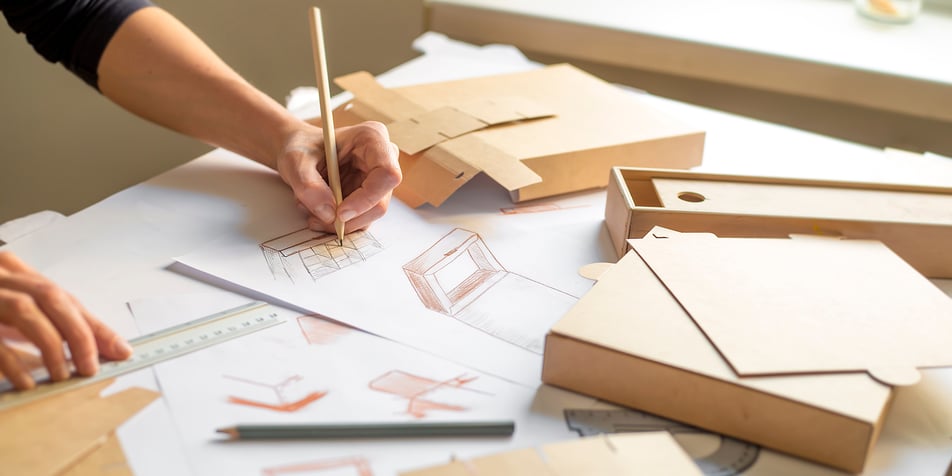
Dimensional weight, nicknamed DIM weight, is an alternate formula used by couriers to determine an item’s shipping cost. Also known as “volumetric weight,” DIM weight accounts for how much physical space your package occupies rather than merely its weight on the scale. If you've shipped items at any point since 2015, you know DIM weight — and its potential to drive up shipping costs — all too well. That’s especially the case if you have a light item in a large box, as couriers calculate both traditional weight and DIM weight, then charge you based on the higher figure.
The introduction of DIM weight has transformed how both B2B and B2C companies think about packaging. Not paying attention to a package’s size in relation to the product inside can drive up shipping costs significantly, even if the package is fairly light when placed on the scale. Although it may seem like a purely cost-driven consideration, optimizing your package’s DIM weight also has an impact on sustainability. And in a landscape where sustainability matters to more consumers, retail partners, C-suites and government bodies than ever before, any measure that enhances cost savings and environmental impact is a major win.
Read on for our quick guide to all things DIM weight, including how to calculate it, how it impacts your packaging sustainability and how to optimize it through savvy engineering and automation solutions. (Hint: To maximize your savings even further, let an expert partner handle that last part.)
How to Calculate DIM Weight
The United States Postal Service (USPS) introduced dimensional weight shipping in 2007, at the time calling it “Shape Based Postage Pricing.” Other carriers followed suit, and by 2015, DIM weight was the established norm — resulting in a major change to how companies approach, and budget for, shipping.
How do you calculate DIM weight? By multiplying length x width x height, then dividing by a preset figure to determine the total cost. FedEx and UPS divide the total by 139, which is their “dimensional divisor” at the time of publication. If your package’s DIM weight is greater than its actual weight, you’ll be charged based on DIM weight.
For a quick example, imagine a bicycle and a kettlebell. Whereas a kettlebell packed into a well-fit box has a high actual weight, the bicycle is relatively light but in a box with large dimensions. So the kettlebell ships with the actual weight rate, while the bike gets charged based on DIM weight.
An optimized DIM weight can deliver major savings on your transportation and shipping costs; not doing so equates to leaving money on the table. But there’s also another significant benefit to being DIM-weight savvy: enhancing your sustainability.
How DIM Weight Impacts Sustainability
A package’s DIM weight also factors significantly into your overall packaging sustainability by impacting your packaging footprint and material waste.
- Your packaging footprint: Simply put, the more space a package occupies, the fewer packages can be delivered on each vehicle. The more vehicles and loads required, the more fuel and emissions required to get your package from Point A to Point B.
- Your material waste: When a box is too large for an item, it increases more than just shipping costs. It also tends to increase the use of void fill, which in turn increases material waste.
How to Optimize Your DIM Weight
Optimizing your dimensional weight is about more than just placing your product into a smaller-sized box. Engineering a right-sized box that meets all performance criteria — as in, protects your product — requires specialized expertise and resources that can be difficult for brands to afford alone. At the same time, new packaging specifications could require new processes and/or machinery, which has the potential to erase many of the cost savings you’ll reap from making the switch. The right partner is critical to maximizing the value of your DIM weight-optimized packaging.
Victory Packaging invests in world-class people, processes, tools, equipment and facilities so that you don’t have to. The result is a partner equipped to optimize not only your packaging dimensions, but to engineer solutions that fit with the packaging processes you already have in place. Because at Victory Packaging, we know that every packaging solution must meet cost, performance and sustainability requirements — all while reflecting your current operations.
Our experienced engineers can develop and test custom packaging solutions that optimize dimensional weight. Then, we can prescribe automation solutions to reduce your shipping and transportation costs, all while delivering a positive impact on our environment. Here’s how we help our customers reduce their shipping costs and footprints through DIM weight optimization.
Engineering Solutions for Optimal DIM Weight
Victory Packaging’s engineers are experts at balancing performance, cost and sustainability. Our designers and engineers have a keen understanding of the cost drivers involved in shipping rates, including how they differ between carriers. We leverage this knowledge to engineer a cost- and performance-optimized solution for each customer’s needs.
We also tap into predictive data modeling, which helps us compare your current shipping costs against the savings opportunities from our proposed packaging design. We pair these solutions with vast expertise in packaging performance, which ensures you don’t have to trade product protection for sustainability or cost savings.
Automation Solutions for Optimal DIM Weight
Victory Packaging is equipped with a full range of packaging automation solutions designed to meet the needs of various applications. That includes machines that can automatically optimize DIM weight. By partnering with Victory Packaging, our customers can benefit from our extensive investment into packaging automation while minimizing their packaging capital expenditures.
Achieve Your Sustainability and Cost-Saving Goals
In today’s complex business landscape, companies have more pressures than ever — many driven by cost, and many driven by sustainability goals. Although sustainable materials are key to reducing your packaging footprint, strategies such as optimizing your DIM weight are equally important and can yield both sustainability and bottom-line gains. From fewer wasted materials to better customer perception, the benefits of optimizing your packaging’s DIM weight abound. Our experts are here to help you make them a reality.
Are you looking for ways to reduce costs, enhance sustainability and ensure optimal packaging performance? Let our experts learn more about your operations and prescribe a tailored, DIM weight-optimized solution.
